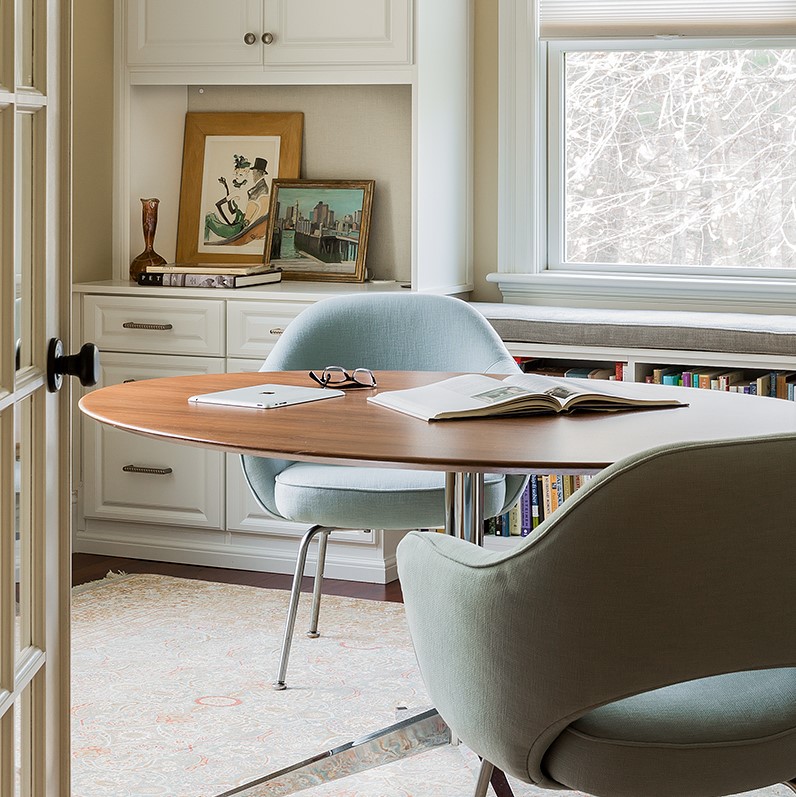
Five Tips for Designing Your At-Home Workspace
by Gabrielle Bove, Lead Designer at Eleven Interiors
Many of us are spending all our time at home and we have had to adapt spaces to serve as adjunct offices, while staying motivated to work efficiently. Whether we are at home alone, with a partner, with extended family, or with children, we are all testing new routines and finding ways of working in the same spaces – those in which we typically eat, cook, sleep, relax and hang out in. The kitchen table or secretary desk where we used to pay bills before quarantine just doesn’t cut it anymore!
With the uncertainty of where we will be working from in the future, we’ve thought a lot about strategies for creating a functional and inspiring home workspace that you can feel good about and where you can be productive.
Here are five tips for designing your At-Home Workspace:
1. Take In Those Views!
You will always be more productive and efficient in a space with natural light and windows if it is an option for you. This may seem obvious, but you will want to set yourself up in a spot with a view to the outside. It is important for all of us to connect with the outdoors when we are inside working all day. If your room has windows, position your table/desk to face a window, or back it into the middle of the room for maximum views. If you have plenty of light and views but are engulfed by the sun’s glare, select a decorative light filtering shade that can provide maximum flexibility and a little extra style.

Photo by: Greg Premru
2. Give Yourself Two Seats
Plan for both a seat at your desk and a seat somewhere else in the room. If you are working in an open space (like your Dining Room or Living Room) then you may already have options available to you. If you can designate a room for your office, then a separate seat can be an invaluable add-on. A lounge chair, chaise lounge, window seat, or daybed will serve as another place to perch when you take phone calls or participate in a virtual meeting. It can also be a place for you to take an afternoon break from staring at your computer. Have fun with color and pattern when selecting this piece – it can also be a focal point!

Photo by: Eric Roth
3. Incorporate Storage
A mix of closed and open storage is usually key for a functioning workspace, even if most of your work is done virtually. Take an inventory of the items you would like to store before you start your search for cabinets or begin designing custom millwork. Do you need a printer, reams of paper, and a place to keep your odds and ends – pens, notepads, paper clips, folders? Consider larger cabinets to store these items out of sight. Incorporate open bookshelves to store items you reach for daily, while also leaving room for decorative pieces or a collection you would like to display.

Photo by: Michael J. Lee
4. Personalize It
Infuse your personality and decorate your workspace with items that will bring you happiness. On my desk, I have a framed picture of my husband, a candle I bought on my honeymoon, a vintage lamp I sourced from an antique market, and a hand-blown glass pen holder that I absolutely love to look at! It is important that your space reflects you since you spend most of your day working there. Paint the walls of your office a color you love and select art for your walls. Lastly, pick light fixtures that speak to you. Instead of utilitarian task lamps, select a decorative ceiling fixture or floor lamp that lights up and out onto your walls and ceiling to create an ambient glow. Next, select a lamp for your desk surface that allows for focused light – this can be any shape, size, or style that speaks to you; it does not have to be a “task” lamp!
![]()
Photo by Greg Premru
5. Make it Multipurpose
Since we now spend so much time in our homes, each of our spaces should serve dual functions and provide us with options for daily activities. When we meet with clients, we always ask in depth questions about their lifestyle to ensure the spaces we create suit their needs. Most of the time, the office is a place where multiple activities take place. When designing your workspace, think about other functional needs that are not met in the house already. Should you plan to have a daybed in your office that pulls out to serve as a bed for guests? Should you incorporate a table in lieu of a desk so it can also be used for family game night or your children’s’ homework station?

Photo by: Michael J. Lee
If you ask yourself these questions and need help with solutions, feel free to reach out to schedule a virtual call with us so we can discuss your design goals and how we can assist!
